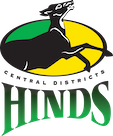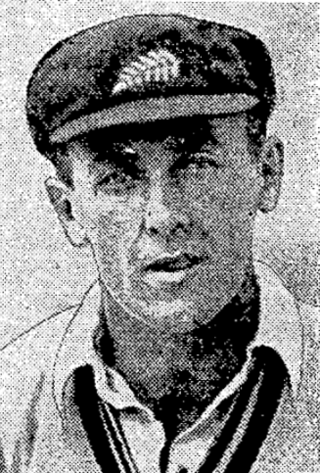Related Research Articles

The Whanganui Rugby Football Union (WRFU) is the governing body for rugby union in the Whanganui region of New Zealand. The Whanganui Rugby Football Union was formed in 1888.

The Central Hinds are the women's representative cricket team of Central Districts Cricket Association, based in central New Zealand. They play their home games at Pukekura Park, New Plymouth, Fitzherbert Park, Palmerston North, Saxton Oval, Nelson and McLean Park, Napier. They compete in the Hallyburton Johnstone Shield one-day competition and the Women's Super Smash Twenty20 competition and were formerly known as Central Districts Women.

The Hawke's Bay cricket team, representing the Hawke's Bay region of New Zealand, played first-class cricket between 1883–84 and 1920–21, and competed in the Plunket Shield in the 1914–15 and 1920–21 seasons. The side has continued to appear in minor cricket and is one of the 21 teams from around New Zealand that compete in the Hawke Cup, where it has been the dominant team from 2020 to 2024.

The Hawke Cup is a non-first-class cricket competition for New Zealand's district associations. Apart from 1910–11, 1912–13 and 2000–01 the competition has always been on a challenge basis. To win the Hawke Cup, the challengers must beat the holders, either outright or on the first innings in a drawn match, on the holders' home ground.
The Northland cricket team represents the Northland region of New Zealand. It is one of the 21 teams from around New Zealand that compete in the Hawke Cup.
Ernest Henry Lovell "Bill" Bernau was a New Zealand cricketer who played first-class cricket from 1914–15 to 1927–28, and accompanied the New Zealand national cricket team on their tour of England in 1927.
The Minor Associations cricket team, representing the Minor Associations in New Zealand, appeared once at first-class level, playing against the touring Australians at the Basin Reserve in March 1921. The Australians batted first and made 271, then the Minor Associations made 124 and 141, losing by an innings and six runs.
The Australia national cricket team toured New Zealand from February to April 1914 and played eight first-class matches including two against the New Zealand national team. New Zealand at this time had not been elevated to Test status. The tour was organized and captained by Arthur Sims, who had previously represented New Zealand. The tour is notable for the fact that it featured Victor Trumper's final appearance in a first-class match before his death at age 37 in 1915.
The Australia national cricket team toured New Zealand from February to April 1928 and played six first-class matches including two against the New Zealand national cricket team. This was before New Zealand began playing Test cricket.
The Taranaki cricket team represents the Taranaki Region of New Zealand. It is one of the 21 teams from around New Zealand that compete in the Hawke Cup.

Lord Hawke selected a cricket team of ten amateurs and two professional players to tour Australia and New Zealand from November 1902 until March 1903. After an opening game in San Francisco, the tour began of eighteen matches - seven of them considered first-class - in New Zealand followed by three further first-class games in Australia. Hawke's team was the first to tour Australasia with New Zealand as the primary destination and, as was the norm at the time, was privately run and funded. The Australian leg of the tour was a "profit making venture", however the games in New Zealand were scheduled at the behest of the New Zealand Cricket Board in order to raise the profile of cricket in the country. Two of them were against a New Zealand cricket team, before its international Test status. The inclusion of such games on the tour were considered "a sign that cricket in New Zealand was starting to be taken more seriously, and a move towards official international status was possible."
Francis Leonard McMahon was a cricketer who played two first-class matches, one of them for New Zealand in 1914.

Chester Arthur Holland was a New Zealand cricketer who played one match for New Zealand in the days before the country played Test cricket.
Thomas Richard Southall was an English-born New Zealand cricketer who played first-class cricket for Wellington from 1913 to 1915.
George Orr was an Australian-born New Zealand first-class cricketer who played for Wellington in the 1920s.

Herbert Norman Lambert was a cricketer who played first-class cricket for Wellington from 1917 to 1933. He played twice for New Zealand in the days before New Zealand played Test cricket.
The Poverty Bay cricket team represents the Poverty Bay region of the North Island of New Zealand. It is one of the 21 teams from around New Zealand that compete in the Hawke Cup. Its base is in Gisborne.
The Hutt Valley cricket team represented the Hutt Valley in the Wellington region of New Zealand between 1928 and 1999. It competed in the Hawke Cup, which it won four times. Cricket in the area is now part of Cricket Wellington.
The Waikato Valley cricket team is a New Zealand cricket team run by the Waikato Valley Cricket Association. It is one of the 21 teams from around New Zealand that compete in the Hawke Cup. Waikato Valley's administrative base is at Seddon Park in Hamilton. The team's main home ground is Victoria Square, Cambridge.
The Rangitikei cricket team represented the Rangitikei region of New Zealand's North Island. It competed in the Hawke Cup from 1910–11 to 1988–89, winning the title twice. The Rangitikei Cricket Association continues to exist, but for inter-provincial purposes Rangitikei is now part of the Whanganui team. Rangitikei's headquarters were in Marton, where its main home ground was Marton Park at first, then Centennial Park, which was established after World War II.
References
- 1 2 "Welcome to Cricket Whanganui". Cricket Whanganui. Retrieved 16 November 2022.
- ↑ "Wanganui". New Zealand Spectator and Cook's Strait Guardian: 3. 12 January 1848.
- ↑ "Advertisements". Wellington Independent: 2. 17 February 1858.
- ↑ "Cricket Match". Wanganui Herald: 2. 24 January 1868.
- ↑ "Wanganui v Australians 1880-81". CricketArchive. Retrieved 8 November 2022.
- ↑ R.T. Brittenden, Great Days in New Zealand Cricket, A.H. & A.W. Reed, Wellington, 1958, p. 21.
- ↑ "Australian Cricket team's Visit Recalls Wanganui's Win by 10 Wickets in 1881". Wanganui Chronicle: 6. 28 February 1950.
- ↑ "The Winning Hit". Press: 1. 21 February 1967.
- ↑ "Wanganui Cricket Association". Wanganui Chronicle: 2. 22 October 1996.
- ↑ Arthur Carman (ed), The Shell Cricket Almanack of New Zealand 1967, Sporting Publications, Tawa, 1967, p. 97.
- ↑ "New Zealand Council". Star: 4. 13 December 1898.
- ↑ "Wanganui v South Taranaki 1912–13". CricketArchive. Retrieved 27 February 2024.
- ↑ "South Auckland v Wanganui 1913–14". CricketArchive. Retrieved 3 March 2024.
- ↑ "Wanganui v Poverty Bay 1918–19". CricketArchive. Retrieved 3 March 2024.
- 1 2 "Glance at Wanganui's Efforts in Hawke Cup Cricket". Wanganui Chronicle: 10. 9 December 1948.
- ↑ Francis Payne & Ian Smith, eds, 2021 New Zealand Cricket Almanack, Upstart Press, Takapuna, 2021, pp. 171–74.
- ↑ McConnell, Lynn (10 November 2000). "Earliest of England to be recorded in boutique book". Cricinfo. Retrieved 6 March 2024.
- ↑ T. W. Reese, New Zealand Cricket: 1914–1933, Whitcombe & Tombs, Auckland, 1936, p. 50.
- ↑ "Wanganui v Poverty Bay 1918–19". CricketArchive. Retrieved 3 March 2024.
- ↑ Don Neely & Richard Payne, Men in White: The History of New Zealand International Cricket, 1894–1985, Moa, Auckland, 1986, p. 258.
- ↑ "Hawke Cup Matches played by Wanganui". CricketArchive. Retrieved 7 March 2024.
- ↑ "Senior Clubs". Cricket Whanganui. Retrieved 4 March 2024.